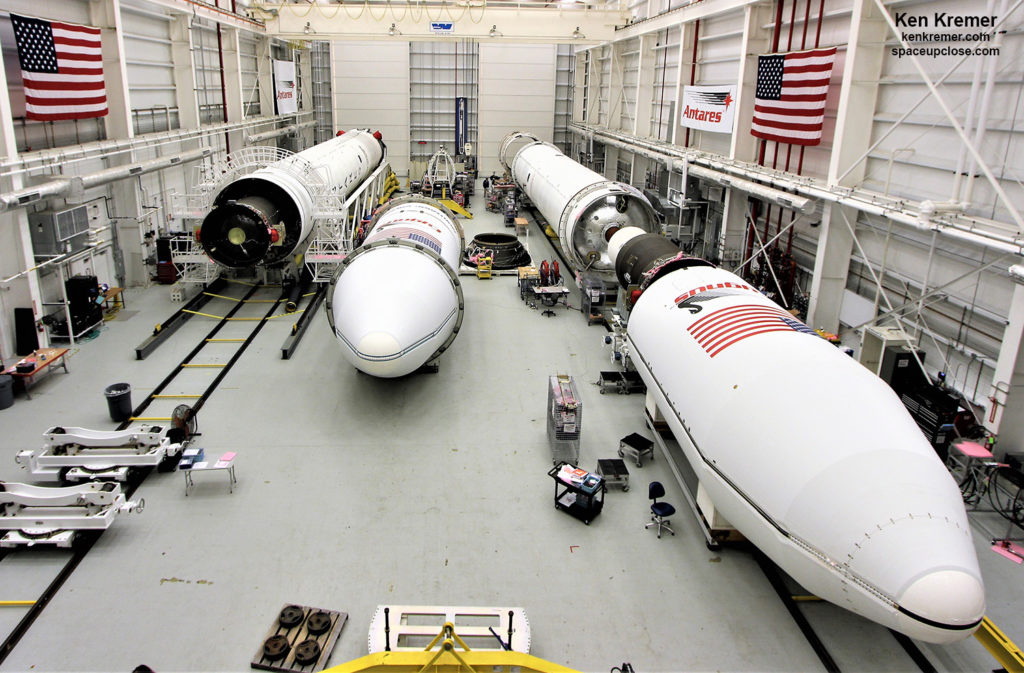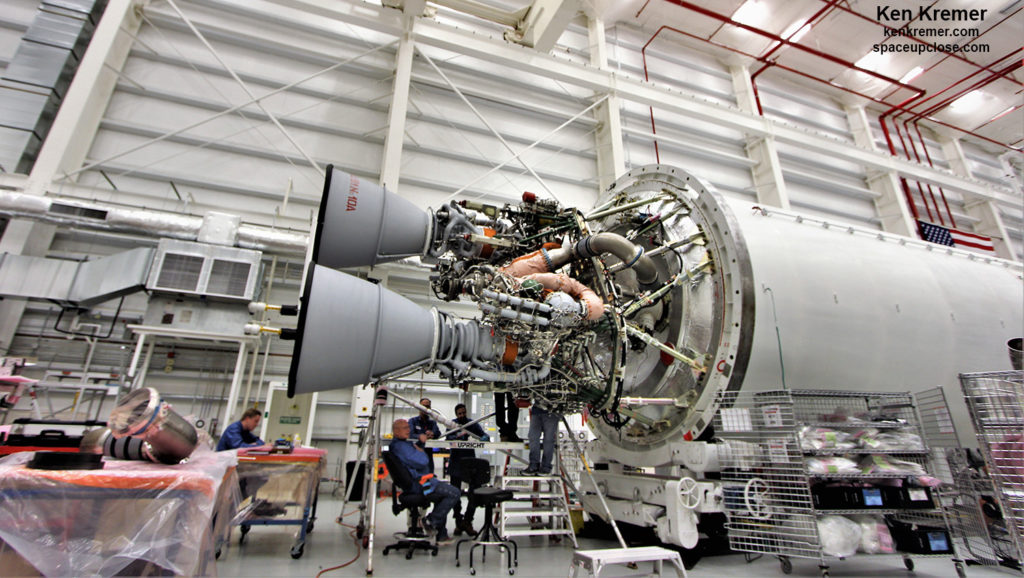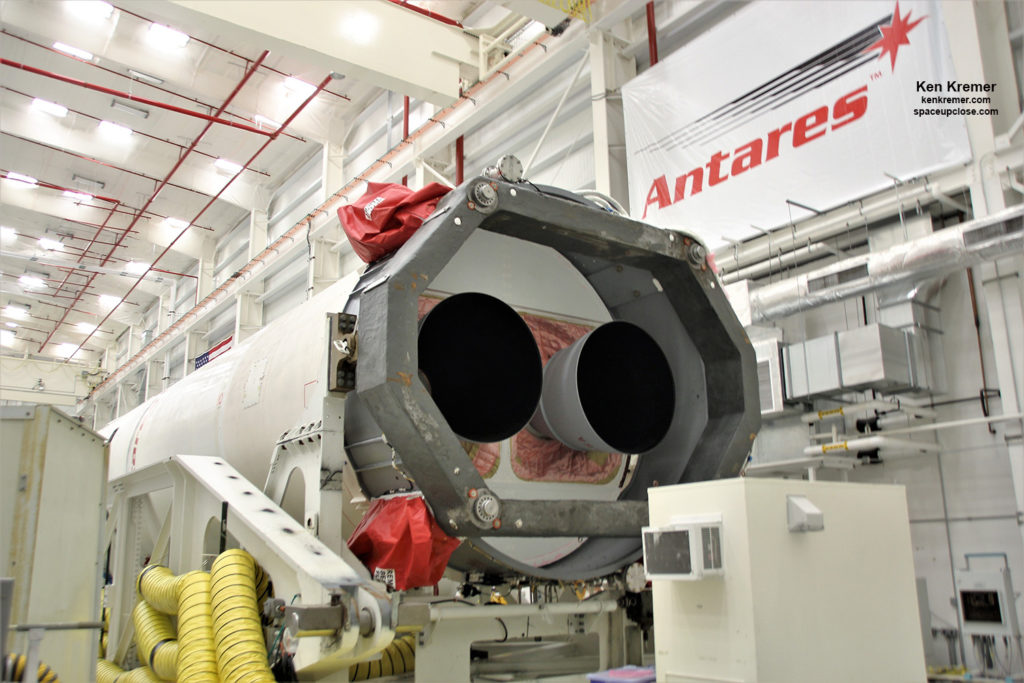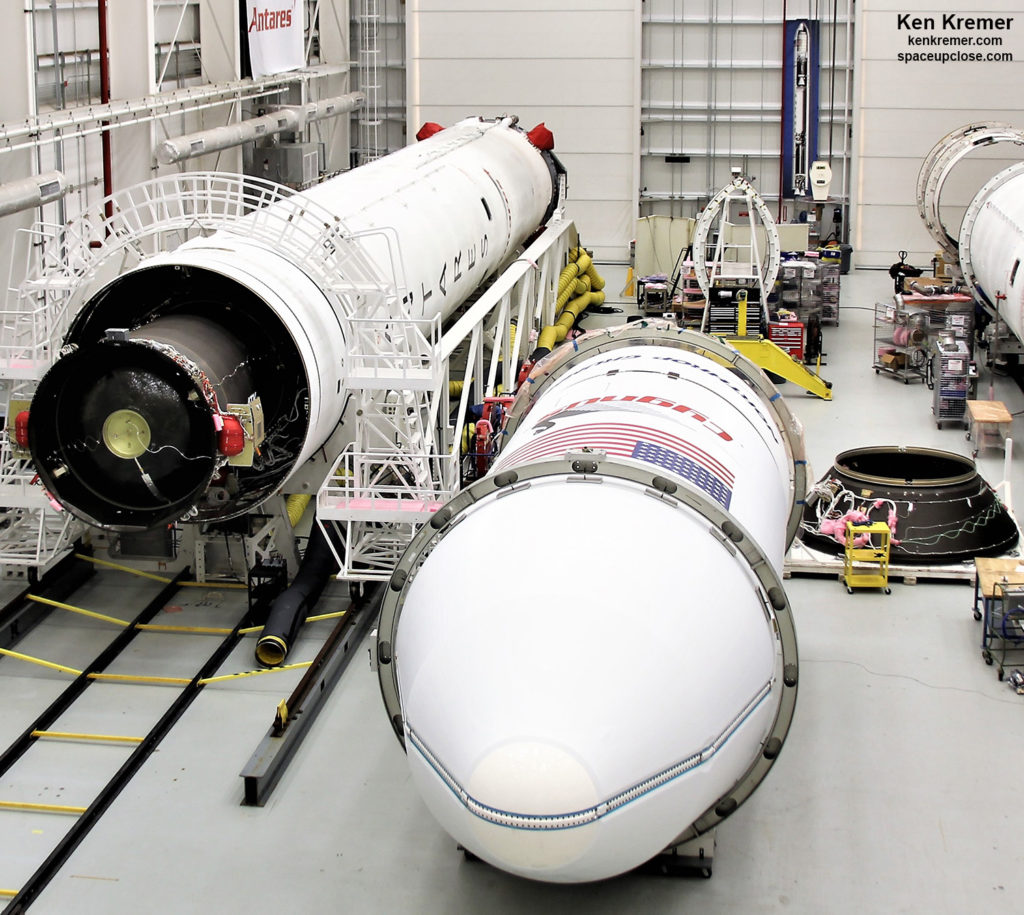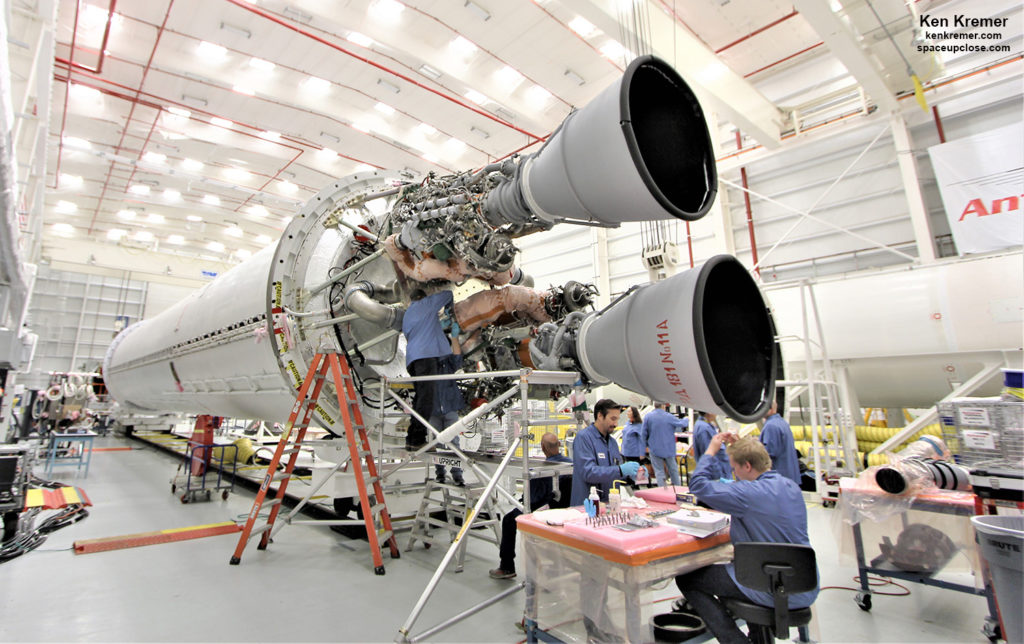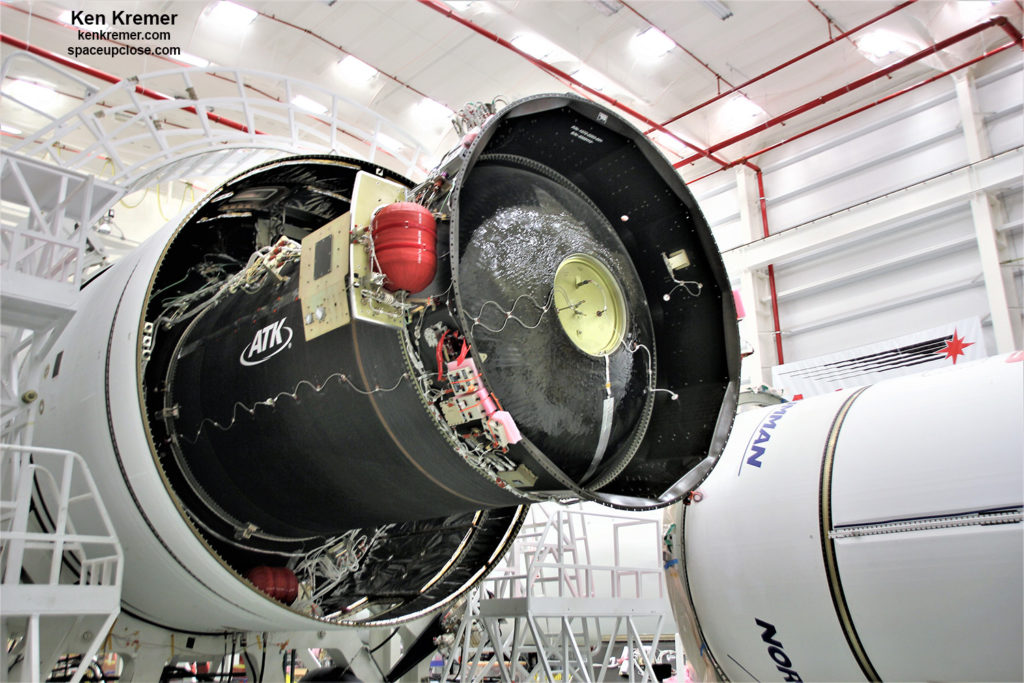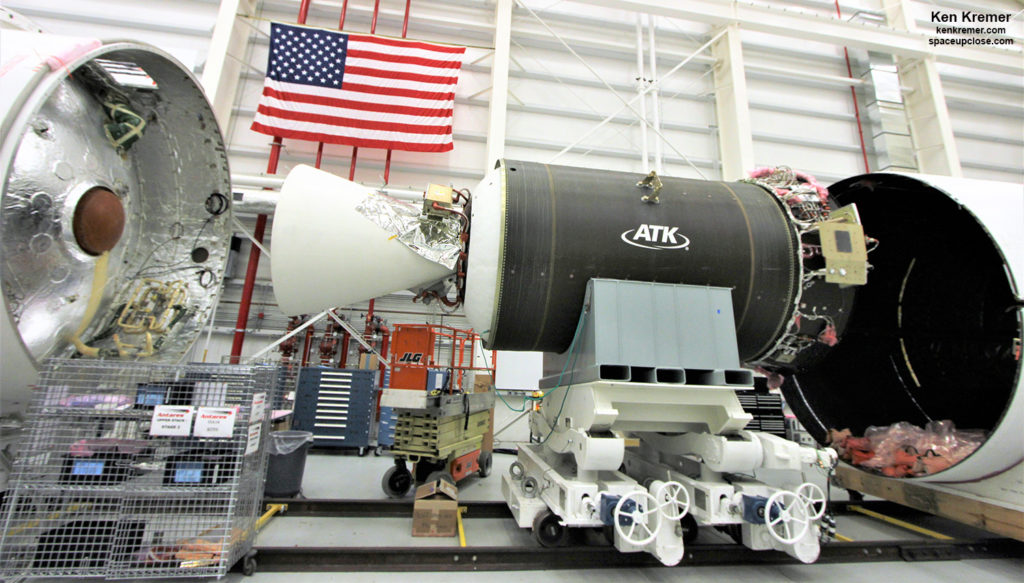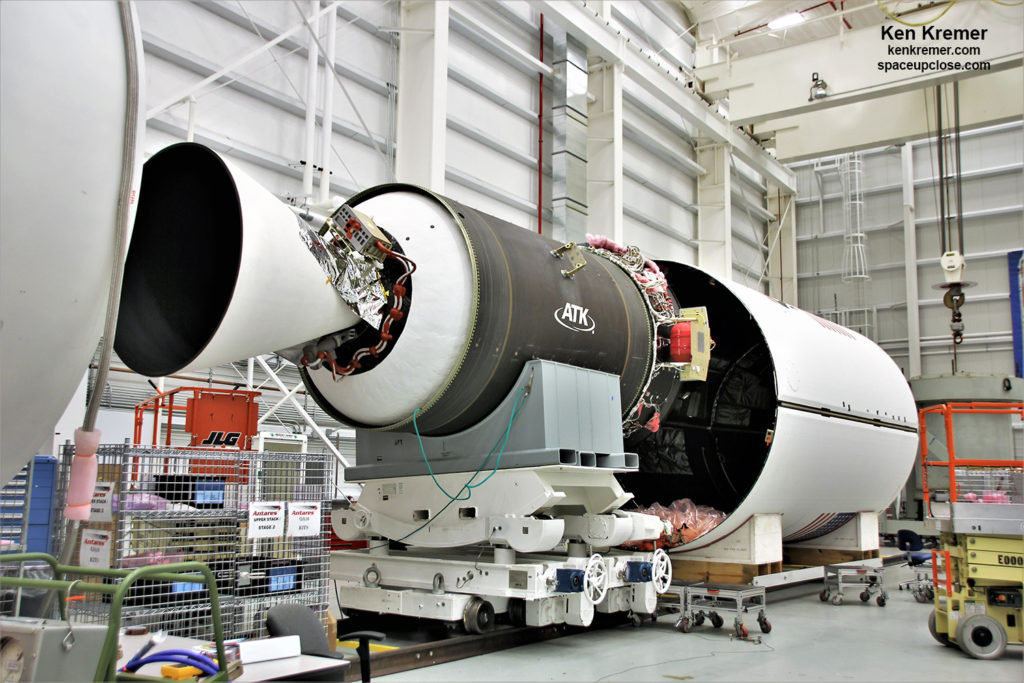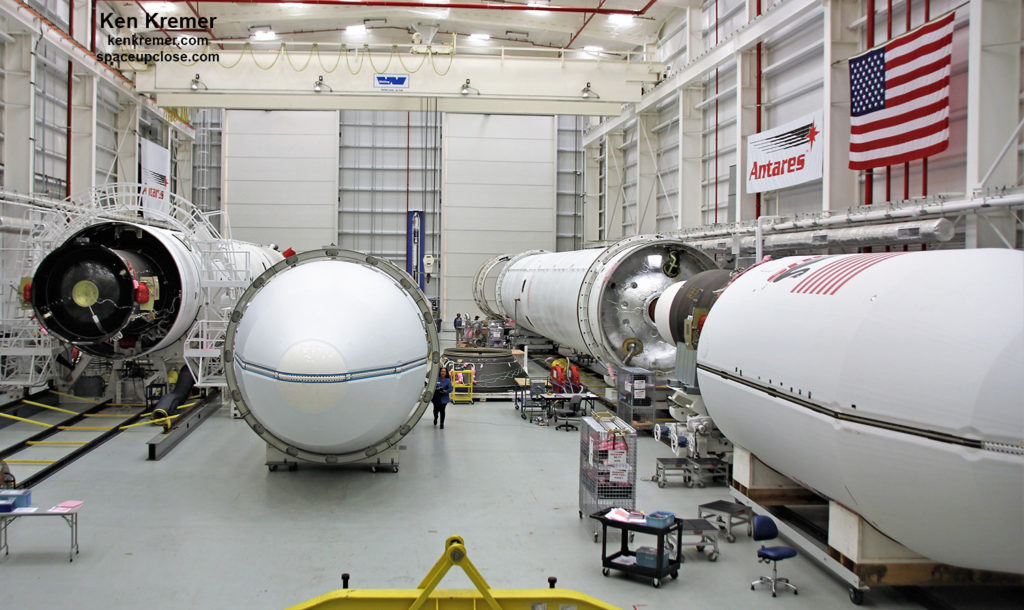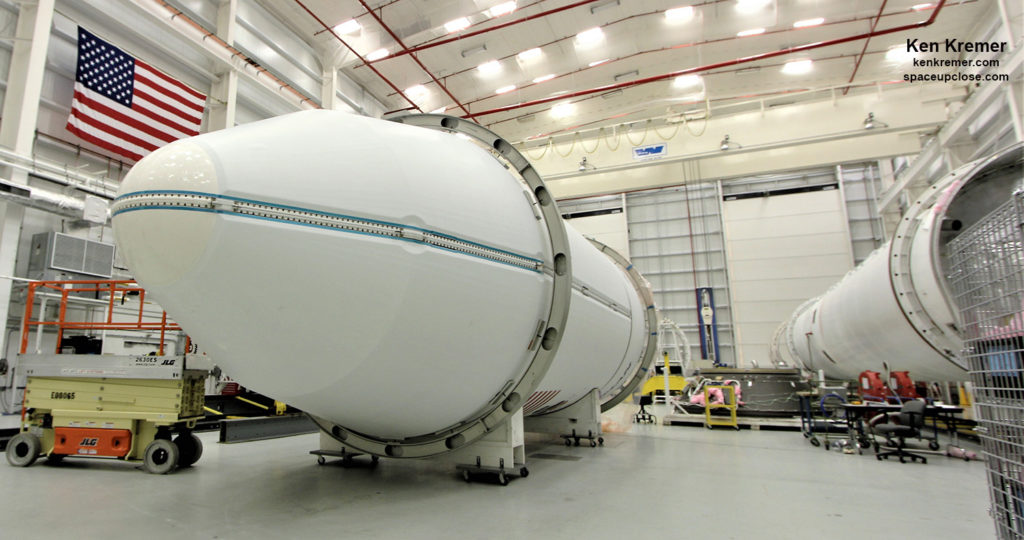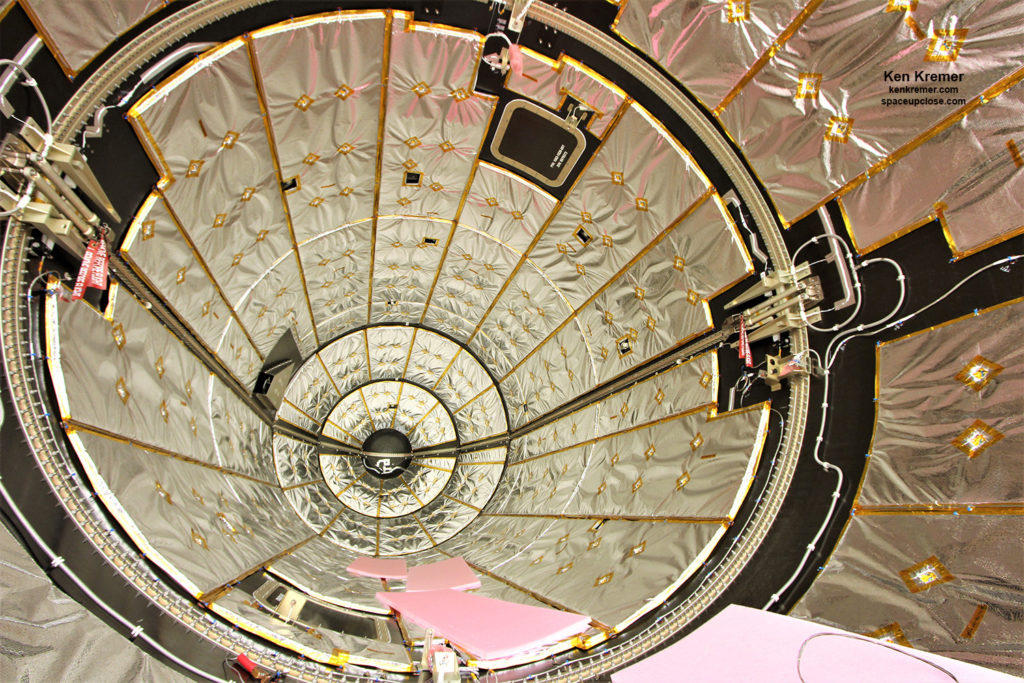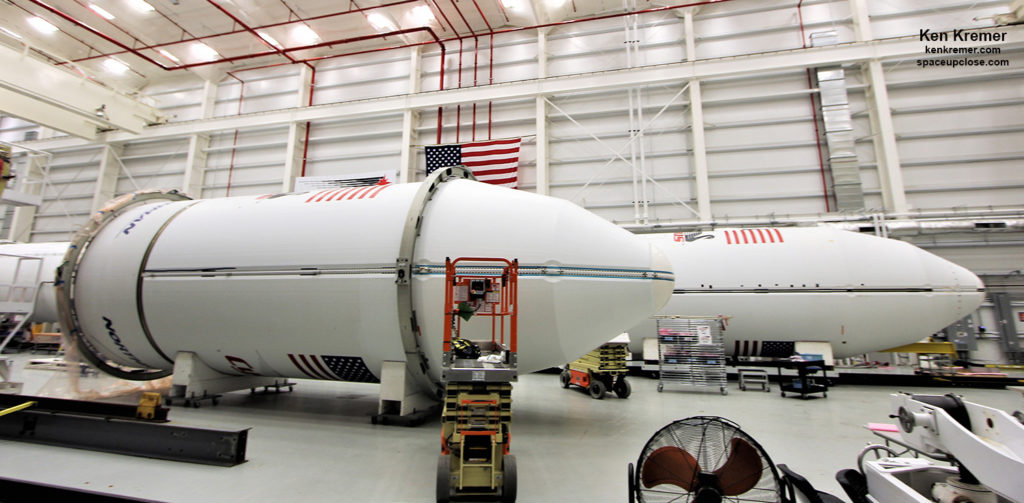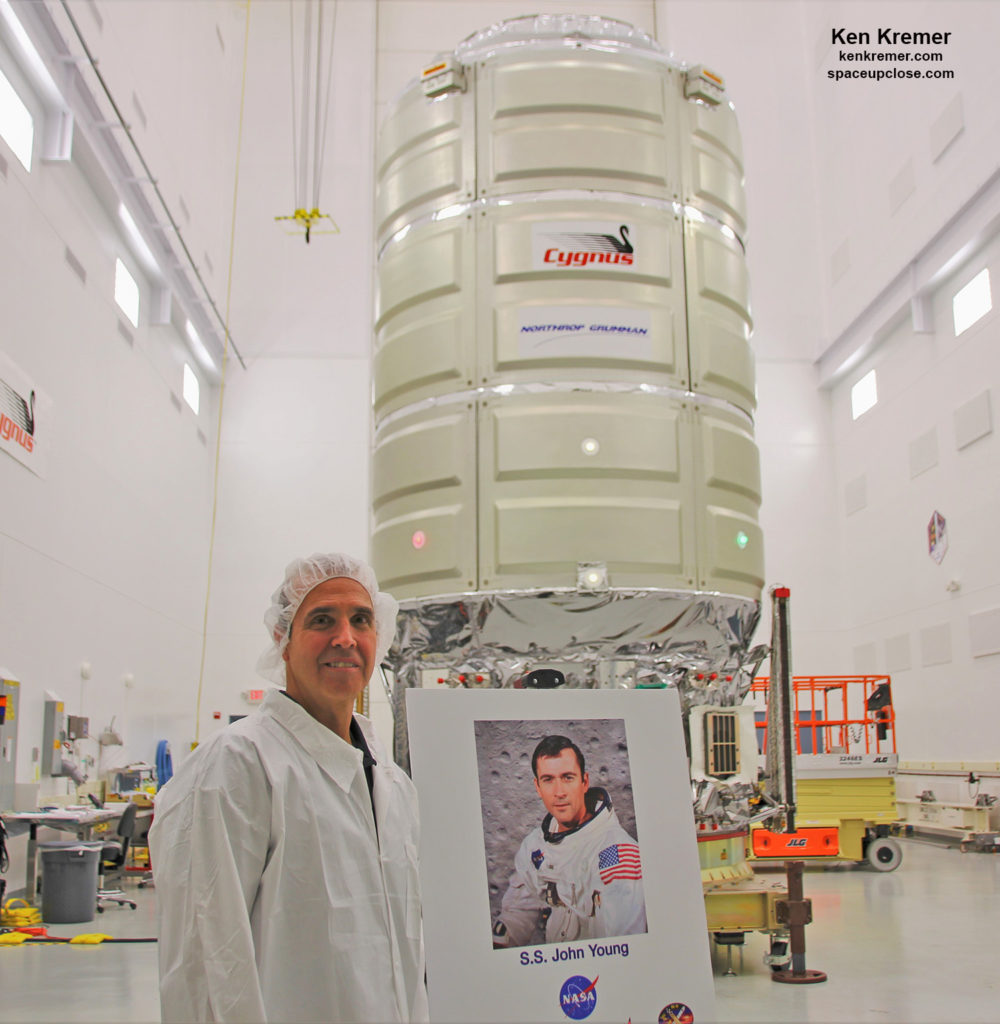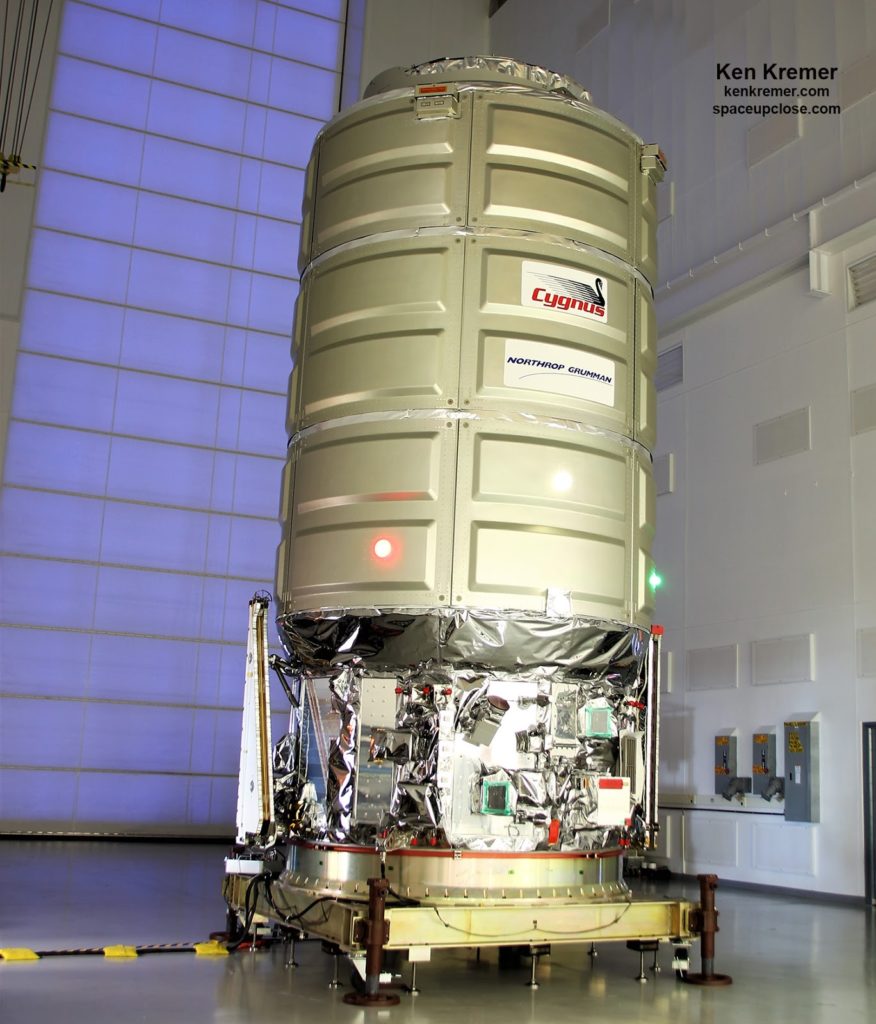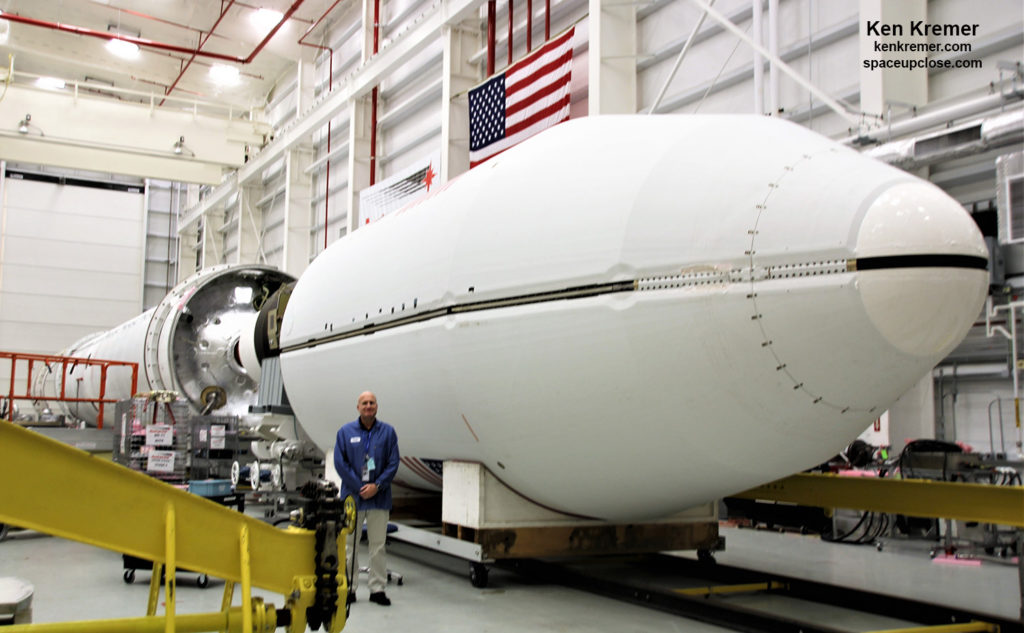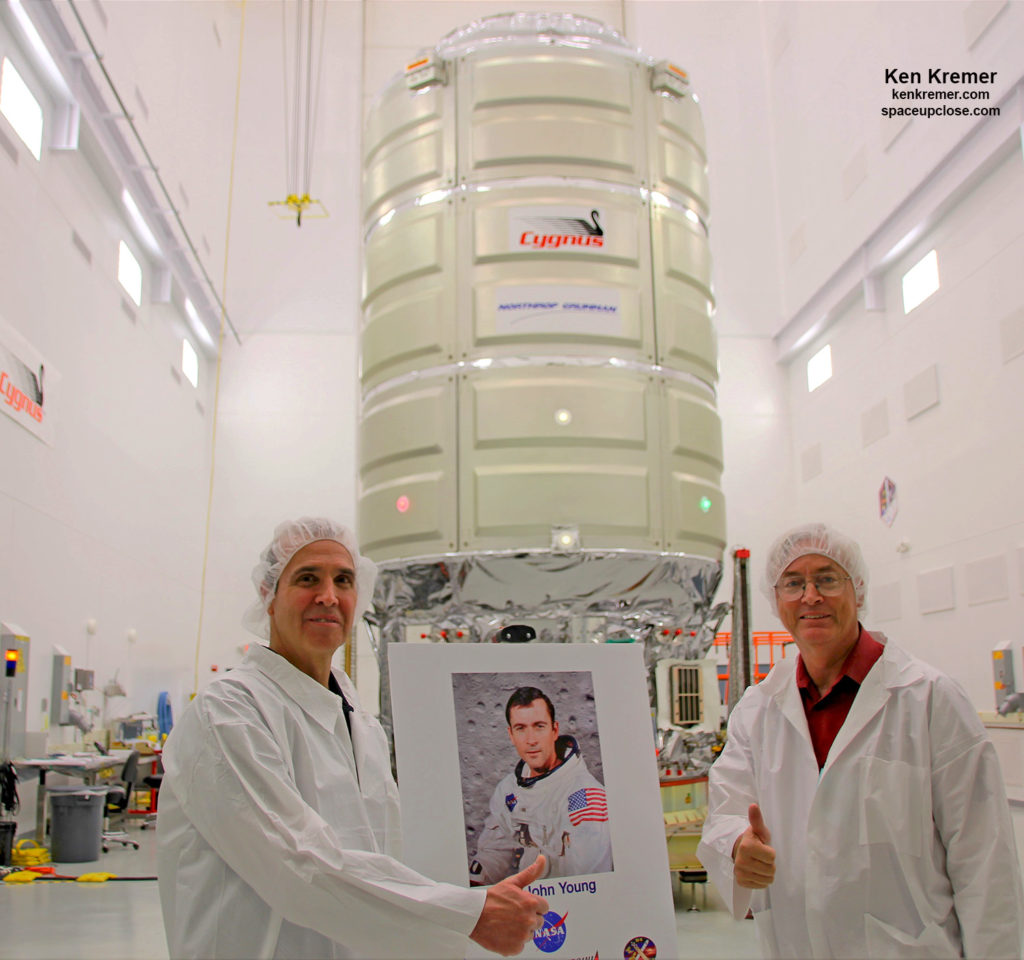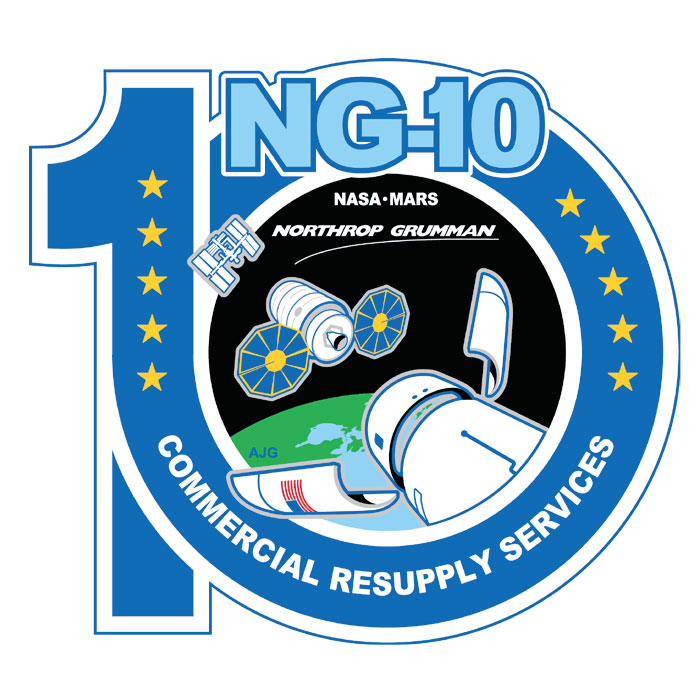Ken Kremer — SpaceUpClose.com & RocketSTEM –11 November 2018
NASA
WALLOPS FLIGHT FACILITY, VA – Everything
remains on track for this week’s launch of Northrop Grumman’s next private Antares rocket hauling the company’s next unpiloted commercial Cygnus
cargo ship to the International Space Station (ISS) from NASA’s Wallops Flight
Facility along Virginia’s Eastern Shore – on a sure to be spectacular overnight blastoff
Thursday Nov. 15.
Space UpClose recently
took an exclusive UpClose tour of the next two Antares rockets being processed side
by side inside the Northrop Grumman rocket assembly factory at Wallops known as
the Horizontal Integration Facility (HIF).
Enjoy our exclusive Space
UpClose photo gallery of the double dose of Antares rockets slated for commercial
cargo launches to the ISS on the NG-10 mission on Nov. 15, 2018 and on the
NG-11 mission in Spring 2019.
We also toured the
Cygnus NG-10 cargo resupply ship up close inside the H-100 cleanroom High Bay processing
facility at NASA’s Wallops, that will deliver over 3.7 tons of precious science
and supplies to the orbiting outpost.
Antares liftoff is scheduled
for 4:49 a.m. EST on Thursday Nov. 15, 2018, roughly 2 hours before sunrise and
should make for an absolutely stunning sight along the Eastern seaboard – home to
America’s most densely populated region.
We observed all the
main components of both the NG-10 and NG-11 booster assemblies – including both
the first and second stages of Antares as well as the RD-181 engines, interstages
and payload fairings.
at this time,” Kurt Eberly, Antares program manager Northrop Grumman VP, told
Space UpClose in an interview during the Antares and Cygnus tours at NASA
Wallops in late October.
NASA and
Northrop Grumman had to do some “re-planning” of the optimum “cargo content” of
the Cygnus NG-10 ISS resupply mission – in the wake of the Soyuz MS-10 crew
launch failure emergency last month from Kazakhstan on Oct. 11, explained former Astronaut and 4 time
space flyer Rick Mastracchio, currently
senior director of Commercial Resupply Services for Northrop Grumman.
What is
the Antares & Cygnus rocket processing sequence leading up to launch?
“The Antares
NG-10 booster is being processed in the HIF,” Eberly explained as we toured the
facility.
“Antares is in position now and has completed its
integrated systems testing. The stages are mated and its ready for Cygnus to be
mated. The payload fairing is ready to go.”
The HIF is a huge rocket processing facility leased from
NASA located about 1 mile (1.6 km) from the Pad OA launch pad.
“We are just doing some final systems testing.”
14 story tall commercial expendable Antares launch vehicle will
be launching in the upgraded and more powerful re-engined 230 configuration rocket
compared to the original version.
The two stage Antares measures 139 feet (42.5 m)
tall and 13 feet (3.9 m) in diameter.
It has a payload capacity of 18,000 pounds (8,000 kg) to
low Earth orbit (LEO).
The core tank was designed and produced by KB Yuzhnoye and
Yuzhmash in Ukraine, and shipped to Wallops, explained Eberly.
“The first stage is derived from the Zenit rocket family.”
It was originally designed as liquid fueled booster for the
Soviet Union’s Energia rocket.
“The first stage is powered by two Russian newly built NPO
Energomash RD-181 engines with independent thrust vectoring. They are fueled by
LOX and RP-1 kerosene.
“They are test fired by Energomash in Russia and shipped to
Wallops.”
They produce about 860,000 pounds of thrust, roughly 100,000
more thrust than the original Antares 100 configuration. They are throttled
down at Max Q to maintain core integrity.
The original Antares was powered by two AJ-26 (NK-33)
refurbished engines whose use was discontinued following the catastrophic launch
explosion of the 3rd ISS cargo flight Orb-3 for NASA on 28 October
2014 and witnessed by this author.
“The second stage is a Castor 30XL solid fueled rocket motor.”
The Castor 30XL’s were originally built by ATK and acquired
by the company then known as Orbital Sciences that then merged into Orbital ATK.
It burns for about 156 seconds with approximately 107,000 pounds of thrust.
The flight proven avionics stage controller was built by
Northrop Grumman from MACH avionics components.
Overall Northrop Grumman is the prime contractor/integrator
and responsible for integration, systems development, testing software and
verification of the combined engines, core stage and avionics components to
ensure they function properly and as designed for a successful launch campaign,
Eberly elaborated.
“On Nov. 1 Cygnus is transported to the Wallops fueling
station in a special dedicated container. After that it moves to the HIF for mating
to Antares.”
“Then its removed from the container and rotated
horizontally and placed on the separation system inside the HIF.”
“Cygnus is then mated to front of Antares.”
The processing team will also load the final cargo items
into Cygnus after arriving inside the HIF.
“Then the rest of the final cargo load and late load items
will be added after it arrives in the HIF around Nov. 1.
“We load the last cargo about three days before launch”.
“Cygnus will be mated to the booster. Finally the payload fairing
will be added [to encapsulate Cygnus].”
“The payload firing is built by Northrop Grumman with a
honeycomb core, composite face.”
The fairing measures 13 feet (3.9 m) in diameter and has a height
of 32 feet (9.9 m).
factory floor.
installed by technicians composed of a laminated aluminum polyimide substrate.
upgraded to allow late load of critical cargo items such as biological samples on
the launch pad using a mobile cleanroom, Eberly explained.
Spring 2019.
the ISS on Antares for the first time.”
Plans call for Antares to roll to the pad sometime on Tuesday,
Nov. 13, two days prior to the schedule Nov. 15 liftoff.
TEL [Transporter-Erector-Launcher] transporter and transported about 1 mile to
the launch pad OA – about 2 days before launch.”
systems test – that tests out the interface between the rocket, the launch pad
and the range.”
sure it’s all looking good”.
countdown. Then we start fueling about 4
½ hours before launch by filling the tanks with RP-1 and liquid oxygen simultaneously.”
sequencer, pressurize the vehicle, and ignite the engines and do a quick health
check.
in May?
last one OA-9 [when the aerospace company was still independently operating as
Orbital ATK] in May of this year 2018,” said Eberly
at 4:49 am, the beginning of a 5 minute launch window.
in flight. Antares is a quick 2 stage flight.
Corporation, was christened the S.S. John Young – in memory of John Young who
was NASA’s longest serving astronaut and passed away earlier this year in
January at age 87.
deliver nearly 4 tons of research experiments and station hardware and crew
supplies to the trio of astronauts and cosmonauts living aboard the orbiting
science outpost after blastoff atop the 2 stage Antares 230 version rocket.
resupply cargo mission for NASA.
recycler and fabricator to aid NASA’s Deep Space exploration
efforts.
station into high-quality 3D-printer filament to create tools and materials, a
key capability for future long-duration space missions beyond low-Earth orbit,”
according to NASA.
comprising science experiments, research gear,
food, water, spare parts, crew supplies and vehicle hardware to support the Expedition 57 and 58 crews.
Cygnus will deliver
vital equipment, supplies and scientific equipment to the space station as part
of Northrop Grumman’s Commercial Resupply Services-1 (CRS-1) contract with NASA
– totaling 11 cargo flights.
“NG-10 is the next to
last followed by NG-11 next spring under the CRS-1 contract, said Eberly.
“Northrop Grumman also
has been awarded the follow-on CRS-2 contract from NASA comprising at least 6
more cargo missions.”
To date, Cygnus
spacecraft have delivered more than 23,000 kilograms of cargo to the
International Space Station, and removed 17,000 kilograms of disposable
cargo.
prior Cygnus cargo freighter was successfully launched by an Antares 230
vehicle from Wallops on May 21, 2018 on the Orbital ATK OA-9 resupply mission
for NASA before the company merged with Northrop Grumman.
continuing onsite coverage of NASA, SpaceX, ULA, Boeing, Lockheed Martin,
Orbital ATK and more space and mission reports direct from the Kennedy Space Center,
Cape Canaveral Air Force Station, Florida and Wallops Flight Facility,
Virginia.
and human spaceflight news: www.kenkremer.com –www.spaceupclose.com –
twitter @ken_kremer – email: ken at kenkremer.com
scientist and journalist based in the KSC area.
Ken’s photos are for sale and he is available for lectures and outreach events


